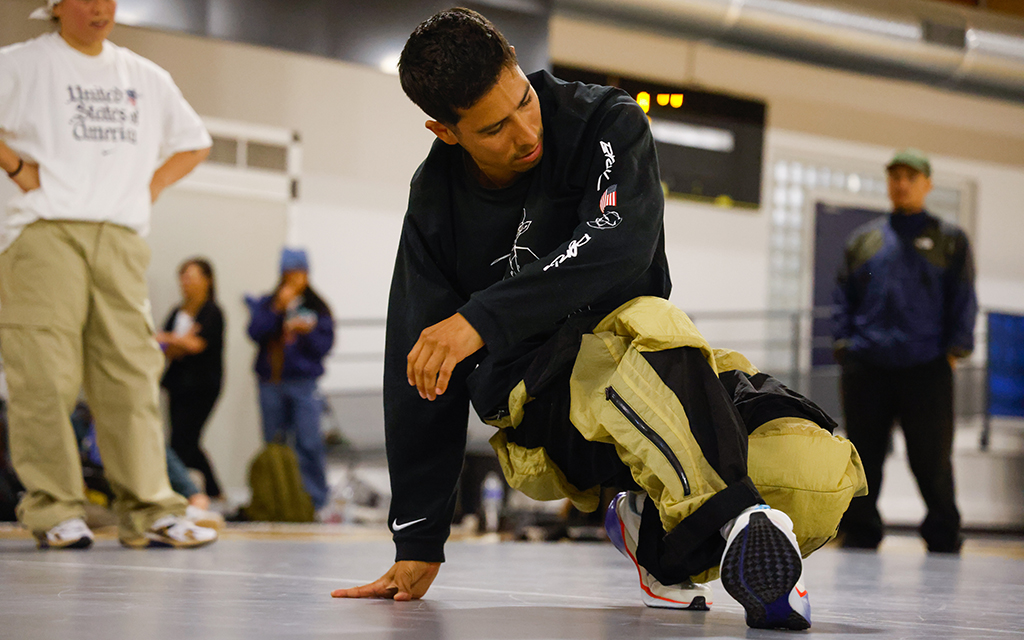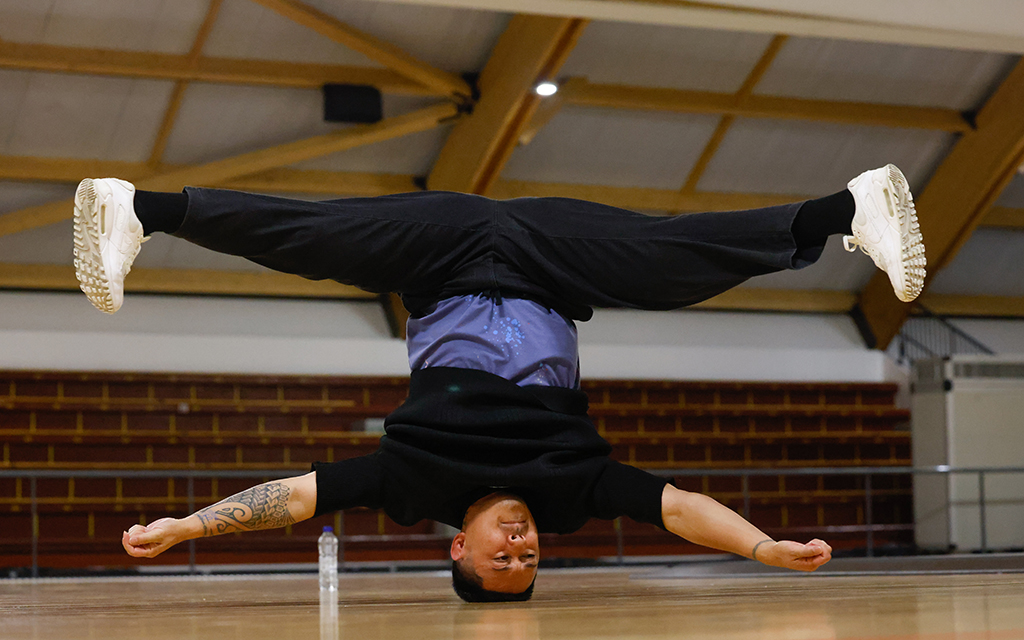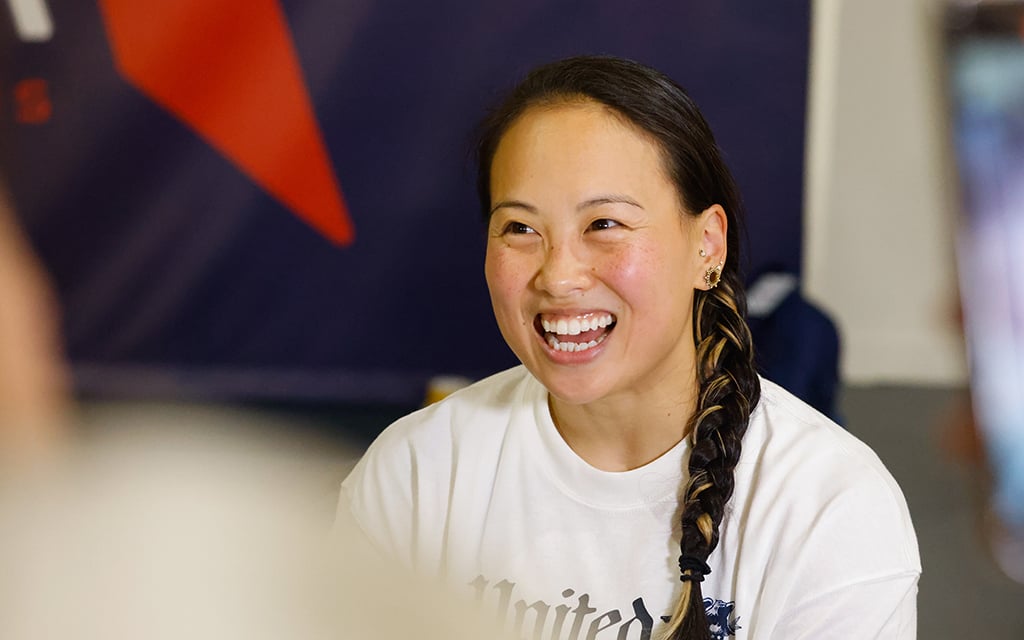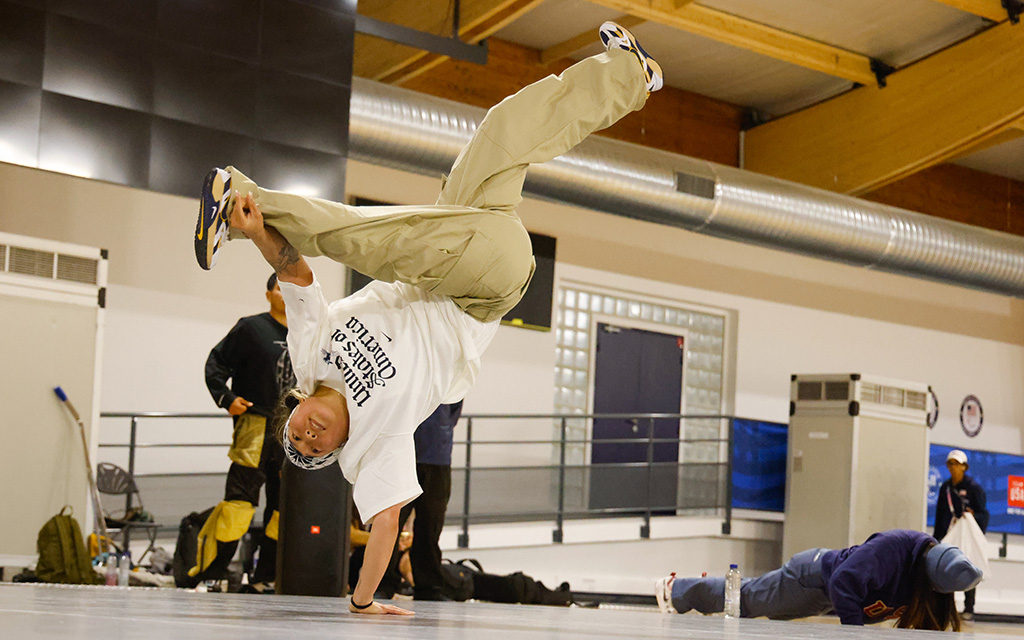U.S. Olympic team breaking athlete Sunny Choi laughs while answering questions during an open practice at the High Performance Center in Paris. (Photo by Sydney Lovan/Special for Cronkite News)

Team USA breaking athlete Victor Montalvo dances at an open practice at the High Performance Center in Paris. (Photo by Sydney Lovan/Special for Cronkite News)

Team USA breaking coach Rynan Paguio practiced moves with the team as they prepare for Friday’s competition at La Concorde Urban Park. (Photo by Sydney Lovan/Special for Cronkite News)
PARIS – Few expressions of human creativity are as freeing as art, and dancing is surely one of its most taxing forms.
Break dancing – officially called breaking – has long been a powerful form of self-expression for urban youth. Originating in New York City, kids have been popping and locking to whatever the currently charting hip-hop tracks were since the late 1960s and early 1970s. Breaking – while at times can be aggressive – is an interactive, intimate, liberating and spiritual connection between the music and dancers.
It makes its Olympics debut Friday at La Concorde Urban Park in the heart of Paris.
“There are so many different types of movements and things you can create,” Team USA breaker Jeffrey Louis said. “That’s the thing that’s pushing the culture in the dance. You have to be free and you have to find ways to create. That freedom of movement just comes naturally and it feels good.”
As the Olympic torch was lit and competition commenced, the world tuned into the greatest collection of athletes all assembled in Paris. For the first time in the game’s history dating back over 3,000 years to Ancient Greek civilization, the world will get to see competitive breaking on the biggest stage. However, the dancers will be competing for more than a piece of jewelry.
“This is something that I’ve been thinking about,” Team USA’s Victor Montalvo said. “My main goal was ‘gold medal,’ then now it’s like ‘wait a minute, I’m representing a whole culture.’ I’m representing the essence of that. We’re going to be at this big Olympic stage. We’re going to have all eyes on us. I just want to make sure that everyone understands what this dance is about because it’s all about peace, unity and having fun.”
Breaking offers an opportunity to dip into a younger market for the Olympics. While traditional sports like track and field, basketball and swimming will always carry marketing weight, there is now an opportunity now to engage a different audience. The 2018 Summer Youth Olympic Games in Buenos Aires was the first Olympic event to host breaking. NBCOlympics.com reported that the sport drew over a million viewers.
“Breaking is something that’s very unfamiliar to the Olympic platform and what it offers,” Vice President of USA Dance Zack Slusser said. “It is a connection to younger generations that are going to bring new viewership to the Olympic platform. What can be achieved through the vehicle of Breaking is just unmatched currently. The energy that the breakers present is what I think is truly unique about it being an Olympic sport.”
He’s projecting a boisterous debut for his sport.
“I wouldn’t be surprised if it is the talk of the games after our competitions,” Slusser said.
The shockwave of the impact that breaking’s Olympics presence could have on the sport is not exclusive to just the athletes competing at that level, but the ecosystem of the sport as a whole. Every level is affected.
The Youth Breaking League – based in the Phoenix metro area – is an organization intended to give an avenue for new or experienced young dancers to consistently practice their craft in organized competitions outside of traditional dance studios. Separate dance studios have a breaking team under coaches such as breaker-turned-coach Chris Ike Sagayo. Those teams then compete regularly against other teams from around the Phoenix area in a league format.
For those who participate, Breaking isn’t something that quite fits the pre-existing mold.

U.S. Olympic team breaking athlete Sunny Choi laughs while answering questions during an open practice at the High Performance Center in Paris. (Photo by Sydney Lovan/Special for Cronkite News)
“Oftentimes, in dance studios, breaking programs don’t succeed because they’re just relegated to a recital,” Sagayo said. “Breaking is more of a communication style dance as opposed to a performance. (It is) more about the social exchange, than the performance.”
The league was founded by breaking community legend and Team USA coach Bonita Saldana. The goal is to develop the sport that has given her so much, from the grassroots level up. It’s a necessary step in the evolution of any sport.
Breaking for Gold USA executive director Tyquan Hodac believes a comparatively under-established sport like breaking needs to be grown from the local level up as opposed to from the national level down. He says that while professionals can compete, there has to be an infrastructure for the youth breakers to thrive in order for the entire sport to continue growing.
“This whole mission was to motivate and inspire a whole new generation,” Hodac said. “What (Saldana) is doing right now really is the epitome of what every other local leadership should be doing throughout the United States of America. Imagine what (Saldana) is doing times 100 in every city and every state. We can do whatever we’re doing on the national and international levels, but the local level must be mobilized. I’m glad to hear (Saldana) is mobilizing for local areas. That’s the leadership that you need.”
The responsibility to lead from the top down is still ever-present in the Olympians, as they hope to present their sport well for the world to drive participation and acceptance of it. That job isn’t lost on them.
“The main thing is just building more opportunities for the youth and creating a pathway, different from what people expect whenever they get into breaking or just dancing in general,” Louis said. “My goal is to be a role model for the youth, we’re the main act. We should create something that’s going to put us in the forefront and create more opportunities for the youth. Something that they can look forward to.”
The sport’s essence is rooted in the community and the competition of displaying your art right across from the opposition, subject to immediate judgment from the contingent of viewers in the form of cheers or jeers.
“(Breaking) needs the exchange as a language to where you communicate.” Sagayo said. “That’s really at the heart and soul. What makes breaking is the battle aspect because that’s your immediate feedback that you know, immediately ‘OK, I’m doing good (or) okay, I need to do better.’”
The sport is traditionally decided by viewer majority opinion. An official scoring system was implemented for the Olympics. Sixteen dancers will battle each other in four groups of four with the top two moving on to a knockout tournament to decide a winner.
Each battle is scored in five categories by nine judges. The categories are vocabulary, execution, technique, musicality and originality. Normally the dancers are subject to crowd feedback to decide a winner. Centralized judging isn’t the biggest challenge the participants face. Their biggest hurdle is actually the DJs who provide the music.
“(The Breakers) don’t know what songs the DJ will play,” Hodac said. “There’s no preset before the battle. They don’t know which songs they’re going to perform. Everything is on the spot and spontaneous. There’s no set routine that they practice. It’s based on the music.”
Breaker Sunny Choi accounts for this spontaneity in her training leading up to an event. She will practice a certain set of moves to have in her arsenal that she can use, but the combination is decided on the spot. There is no set routine in place, she is at the discretion of the DJ and the onus is on her to weave together a captivating performance no matter what tune is thrown her way in battle.
“We literally hear the track when the DJ drops it,” Choi said. “If you’re the first one to go out, you have about five seconds.n If you don’t give yourself that room to be able to connect with the music, everyone in the room is going to know.”
The weight of what these dancers will carry – for more than just themselves – when they’re twisting, flipping and dancing for the world at large, isn’t lost on them. Choi and her fellow teammates are emotionally moved at the realization of what they get to represent come her time to shine in Paris.
They’re not breaking for a medal, personal glory or media but the future of the sport. The world’s eyes will be watching the masters perform their art and self-expression, especially the youngest eyes like the ones in the Youth Breaking League. Success can lead to bigger events for the sport in the future and several new children devoting their time to advancing the breaking craft after seeing their heroes compete on the world stage.
“I have so much gratitude and pride to be able to represent our community,” Choi said. “You know, we came from the streets in black and brown communities. Breaking has really kind of globalized, and now we have this, like, extremely beautifully diverse world, because breaking is a lot more accessible than a lot of other sports and art forms that are out there. We all get to share in something that transcends language, even, you know. I feel so lucky to be able to represent these people.
“It’s something that I love so much, so I’m really excited to be able to do this and show the world what we love.”

